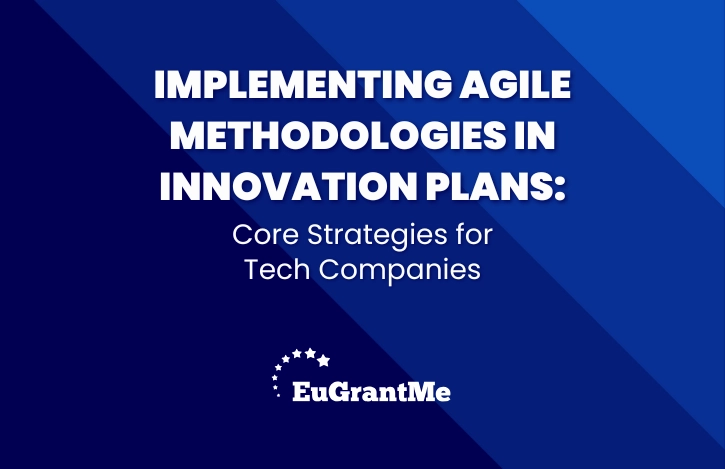Tech companies must continuously innovate to stay competitive. The fast-changing market demands flexibility, speed, and adaptability. Agile methodologies in innovation offer a structured yet dynamic approach to managing projects. These methods improve collaboration, streamline processes, and enhance responsiveness.
Agile methodologies in innovation focus on iterative development, continuous feedback, and adaptive planning. They help companies navigate uncertainty and integrate customer needs into product development. By adopting agile principles, tech firms can enhance efficiency and deliver impactful solutions.
The Role of Agile in Driving Innovation
Agile methodologies enable teams to respond quickly to change. Unlike traditional linear models, agile frameworks prioritise flexibility. Teams work in short cycles, adjusting plans based on real-time insights. This approach ensures that innovation aligns with market demands.
Cross-functional teams play a key role in agile innovation. Collaboration across departments improves problem-solving and accelerates decision-making. Agile fosters a culture of experimentation, where failures become learning opportunities. This mindset encourages continuous improvement and adaptability.
Key Agile Frameworks for Innovation
Several agile frameworks support innovation. Each offers a unique structure while maintaining core agile principles. Selecting the right framework depends on company size, industry, and project scope.
Scrum is a widely used framework that organises work into short cycles called sprints. It promotes regular feedback and incremental improvements. Scrum teams hold daily stand-up meetings to discuss progress and challenges.
Kanban focuses on visualising workflows and reducing bottlenecks. Teams use boards to track tasks, ensuring smooth progress. This framework enhances transparency and helps prioritise tasks effectively.
While not directly is agile, Lean Startup applies agile principles to product development. It emphasises rapid prototyping, customer feedback, and iterative learning. This method reduces risks and optimises resource allocation.
Creating an Agile Culture in Tech Companies
Implementing agile methodologies in innovation requires cultural transformation. Leadership must foster an environment of trust and collaboration. Open communication and knowledge sharing enhance team alignment.
Encouraging experimentation is crucial. Employees should feel comfortable testing new ideas without fear of failure. Agile thrives in a setting where learning from mistakes leads to better outcomes.
Training and coaching support the transition to agile practices. Workshops and mentoring sessions equip teams with necessary skills. Continuous learning strengthens agile capabilities and improves implementation.
Enhancing Flexibility in Product Development
Agile methodologies in innovation promote flexibility in product development. Traditional models often follow rigid planning structures. Agile allows teams to adjust based on market feedback.
Short development cycles enable quick iterations. Prototypes and minimum viable products (MVPs) allow early testing. This approach minimises risks and ensures products meet customer expectations.
Customer involvement is central to agile innovation. Regular feedback loops guide improvements. Companies that engage users throughout development create products that truly address market needs.
Collaboration Across Departments and Teams
Agile methodologies break down silos within organisations. Cross-functional collaboration enhances efficiency and innovation. Teams from engineering, marketing, and design work together from project inception.
Shared goals align team efforts. Agile frameworks encourage frequent discussions and updates. This transparency improves decision-making and accelerates project timelines.
Using collaborative tools enhances communication. Platforms like Slack, Jira, and Trello help teams track progress. Real-time updates ensure alignment and prevent delays.
Optimising Resource Allocation with Agile
Resource management is essential in agile innovation. Agile frameworks help companies allocate time, talent, and budget efficiently. Teams prioritise high-impact tasks, avoiding unnecessary work.
Backlog management keeps projects on track. Agile teams maintain a list of tasks, updating priorities based on evolving needs. This practice prevents resource waste and optimises productivity.
Agile also improves scalability. Companies can adjust team structures and workflows as projects grow. This flexibility supports sustainable innovation and long-term success.
Overcoming Challenges in Agile Implementation
Adopting agile methodologies in innovation presents challenges. Resistance to change is common. Employees accustomed to traditional methods may struggle with agile principles.
Leadership plays a key role in managing transitions. Clear communication about agile benefits encourages adoption. Providing support and training ensures a smoother shift.
Maintaining agility in large organisations requires structured frameworks. Scaling agile across departments involves standardised practices. Tools like SAFe (Scaled Agile Framework) help larger enterprises implement agile effectively.
Measuring Success in Agile Innovation
Tracking performance is crucial in agile methodologies. Companies use key metrics to evaluate progress and impact. Common agile performance indicators include:
– Velocity: Measures the amount of work completed in a sprint.
– Lead Time: Tracks the time from task initiation to completion.
– Customer Satisfaction: Assesses how well products meet user expectations.
– Cycle Time: Monitors the duration of development processes.
Regular retrospective meetings enhance learning. Teams analyse what worked well and what needs improvement. This continuous feedback loop strengthens agile implementation.
The Future of Agile in Tech Innovation
Agile methodologies in innovation will continue evolving. Emerging technologies like artificial intelligence and automation enhance agile practices. AI-driven analytics provide real-time insights for decision-making.
Remote work has also influenced agile adaptation. Distributed teams use digital tools to maintain collaboration. Virtual agile workshops and stand-ups keep teams connected.
Companies that embrace agile will remain competitive. Flexibility, adaptability, and efficiency are essential in a rapidly changing market. Agile fosters a mindset that drives continuous innovation and long-term growth.
Final Thoughts
Agile methodologies in innovation provide tech companies with the flexibility to navigate complex markets. These frameworks enable faster product development, efficient resource use, and enhanced collaboration. Companies adopting agile gain a competitive edge in an increasingly dynamic industry.
By fostering an agile culture, businesses can sustain innovation and respond quickly to market shifts. Agile is more than a methodology; it is a mindset that drives success. Embracing agile will help tech firms adapt and thrive in an ever-evolving landscape.
At EuGrantMe, we are passionate about fostering innovation and empowering ambitious minds to flourish. Our mission revolves around providing top-notch grant writing services for the EIC Accelerator and Horizon grants in Europe. We enable our customers to unlock the full potential of their ground-breaking ideas.
Do you have a project to turn into reality?
Contact us!


